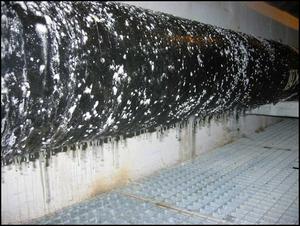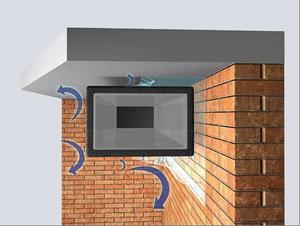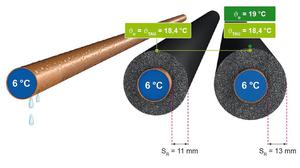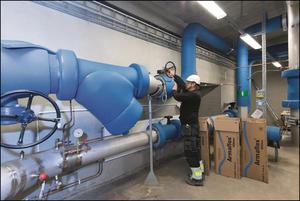

|
Edward Lowton
Editor |


|
| Home> | Premises management/maintenance | >HVAC | >Condensation control and insulation |
| Home> | Energy Management | >Insulation | >Condensation control and insulation |
Condensation control and insulation
27 January 2015
Correctly specified insulation can prevent condensation forming on refrigeration pipe work systems. Here, Michaela Störkmann, Armacell technical department manager EMEA, looks at how a better understanding of condensation and advances in insulation performance is leading to improved specifications.

"Whilst hot installations (heating and hot-water pipes) are predominantly insulated to save energy, cold systems (such as the chilled-water pipes of air-conditioning systems or the suction lines of commercial freezers) need protection against condensation. On refrigeration systems, where the line temperature is lower than the ambient temperature, condensation is formed when water vapour comes into contact with the colder surfaces of the pipework and equipment.
Eventually, this condensation can result in considerable damage. Apart from the expense of repairing, there may be further maintenance costs resulting from wet ceilings, spoilt goods or disruption to production processes. Moreover, the insulation effect of a material deteriorates greatly when it becomes damp, resulting in large increases in energy losses and corrosion of the equipment from the moisture in the insulation.
Why condensation occurs
Condensation occurs simply because there is only so much water vapour that air can absorb. At 100% saturation, known as the ‘dew point’, the air is completely saturated causing moisture to be released in the form of droplets on cold surfaces.
At a given temperature and with a given relative humidity, the air contains a defined amount of water vapour. If air is cooled down, it reaches this 100% saturation at a specific temperature. If the air is cooled further, some of the water can no longer be held in the form of invisible water vapour and begins to form liquid droplets. Warm air is able to absorb more water vapour than cold air and so air that is cooled below the dew point will result in the formation of moisture on pipes and equipment.
The respective water vapour content of air at a given temperature can be calculated to work out the extent to which air of a certain relative humidity can cool without 100% saturation being exceeded and therefore condensation forming.
Maintaining temperature above the dew point to avoid condensation
Applying this physical law to refrigeration applications means that the insulation thickness must be designed so the temperature never falls lower than the dew point anywhere on the surface of the insulation material.
An ArmWin app allows insulation thicknesses to be correctly calculated to avoid condensation forming on pipes and equipment.
In order to prevent condensation, the surface temperature of the insulation must be as high as, or higher than the dew point temperature under defined ambient conditions.
There is a relatively straightforward way of calculating the insulation thickness required to ensure that the surface temperature of the insulation is at least as high as this dew point. This involves knowing the line temperature and the ambient conditions (ambient temperature and relative humidity), defined as expected maximum values. In addition, it is necessary to determine the thermal conductivity of the insulation material, the object being insulated (pipe, duct and equipment) and the heat transfer coefficient of the surface of the insulation.
Although these variables should be calculated by the insulation specialist or installer, it is useful for the specifier to know how these individual factors influence the insulation choice and its maintenance.
Influencing factors
Ambient conditions
In order to determine the minimum thicknesses for low-temperature insulation, assumptions must be made about typical ambient conditions.
A common mistake is to underestimate the impact of the relative humidity on the insulation thickness required to prevent condensation. For example, in some areas a 10% increase in humidity can mean the insulation needs to be twice as thick.
The thermal conductivity of the insulation material
The thermal conductivity value of materials typically used for technical insulation range from 0.030 to 0.060W/(m²K). One parameter which influences the thermal conductivity is the mean temperature. In the case of elastomeric insulation materials, such as AF/Armaflex Class O, the thermal conductivity increases as the temperature rises.
This has a decisive influence on the insulation thickness, because the lower the thermal conductivity, the thinner the insulation thickness. The thermal conductivity of materials should therefore be shown in combination with the mean temperature.
The heat transfer coefficient
The heat transfer coefficient depends on the type of flowing medium, the flow speed, the character of the wall surface (rough or smooth, shiny or dark) and other parameters. The heat transfer coefficient usually consists of heat transfer through convection and heat transfer through radiation.
Convection makes a substantial contribution towards improving the heat transfer coefficient. The faster the ambient air flows, the more heat is transported. Therefore, in practice and when designing plant, it is essential to ensure that pipes and ducts have sufficient clearance to each other, walls and other installations. If this isn’t done it will prove difficult to install insulation materials correctly and there is also the danger of a build-up zone being created. In such areas, the air circulation (convection) required to create a sufficiently high surface temperature above the dew point is prevented. In these build-up zones, the heat transfer coefficient is lower. As a result, the risk of condensation and frosting increases significantly.
A build-up zone clearance of 100mm is recommended between insulated pipes as well as between the pipes and the nearest wall or ceiling. In the case of vessels and other equipment, the distance can be increased up to 1000mm.
Thermal radiation is a type of heat transfer that occurs through electromagnetic waves. The transfer of energy through radiation is not restricted to one transfer medium. For example, unlike thermal conduction or convection (heat flow), thermal radiation can spread in a vacuum. In the case of thermal radiation, the mechanism of heat transfer consists of two sub-processes:
•Emission: on the surface of a body with a high temperature, heat is transformed into radiation energy.
•Absorption: the radiation which strikes the surface of a body with a lower temperature is transformed into heat.
Dark-coloured bodies emit more radiation energy than light-coloured ones and inversely, dark-coloured bodies absorb more thermal energy than light-coloured ones.
The measure for the emissive power of a material is the emission coefficient, whilst the measure for the absorptive power is the absorption coefficient. Interestingly, the emissive power of a body of a certain colour is as great as its absorptive power, for instance, a vessel that is completely black has the greatest absorptive or emissive power. These factors need to be taken into account when specifying insulation on a refrigeration system.
Determining insulation thicknesses
Another crucial factor when calculating the insulation thickness required to prevent condensation is whether the object to be insulated is a flat surface or cylindrical object (pipe). In the case of cylindrical objects the logarithmic ratio of the diameter of the insulated pipe to that of the un-insulated pipe must be included in the calculation. One of the consequences of this is that thinner insulation thicknesses are required on pipes compared to flat surfaces.
To avoid having to carry out such complex calculations, the ArmWin Thermal Insulation Thickness Program can provide all the typical calculations required for the refrigeration, air-conditioning, heating and plumbing sectors.
The tool has been updated for use online, offline and as an app, allowing technical calculations to be carried out far more easily and quickly. New features include the possibility of entering individual data on the project in question and storing calculations as a pdf. The program is linked to product information on Armacell's website with a glossary to explain key terms.






















